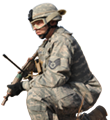Bullet Points on the Guard’s history
When viewed as a series of 20-year enlistments, the Guard today is mid-way through it's 19th "re-up." Throughout it all, the Guard has proven that it's "Always Ready, Always There."
How have those 20 generations of American Citizen-Soldiers served?
- The Guard birthday is Dec. 13, 1636, the date that the first regiments of militia were organized from militia companies in the towns surrounding Boston.
- Even before that date, there was militia defending the settlers in this new world.
- In Virginia, the militia was organized with the founding of the very first settlement, Jamestown, in 1607. To date, 412 years of militia in Virginia. Professional soldiers like Capt. John Smith were brought from the old country to train these citizens in the rudiments of soldiering, as defending the colony was a fundamental obligation that every adult male shared.
- The first generations of militia fought with swords, pikes, and unwieldy matchlocks that took more than 50 steps to load and fire, and wouldn't function in the rain.
- Generation 7 responded to Paul Revere's ride and formed up to battle the British at Lexington and Concord. They carried flintlocks, hunting riles, shotguns, and hatchets - the implements of farmers and tradesmen defending their liberties against the incursions of an overbearing and distant monarch.
- Their sons in Generation 8 fought the British again in a war many called the Second American Revolution. They defeated a land assault on Ft. McHenry - which if it had succeeded, would have led to the capture of Baltimore and the loss, among other things, of the inspiration for our national anthem. At the mouth of the Mississippi, a militia army under future-president Andrew Jackson saved another American city, New Orleans, defeating the same British regiments that had humbled Napoleon just a year earlier.
- Generation 12 faced off, brother against brother, in the Civil War. The militia functioned as it was supposed to - both North and South - and formed the cadre for hundreds of volunteer regiments that organized after Bull Run. Rifled muskets loaded with Minie balls ensured rapid and deadly fire out to 600 meters, contributing to a bitter protracted struggle that would claim more lives than all other American wars combined.
- Generation 14 rushed to the colors and "Remembered the Maine" during the Spanish-American War. The tiny regular Army of 25,000 quadrupled in size virtually overnight as militia units volunteered to a man for overseas service. Former New York National Guardsman and future president Theodore Roosevelt charged up San Juan Hill with a regiment of U.S. Volunteers that was largely made up of New Mexico militia. 103 years later he would receive the Medal of Honor for his actions.
- Generation 15 doubled the size of the Army when it was mobilized for World War I and quickly went "Over There." Forty percent of the divisions that saw combat, and forty percent of the casualties in World War I, were Guardsmen. Armed with Springfield rifles and bayonets, they slogged through trenches and went "over the top" to end a war that had exhausted Europe. The German General Staff rated eight American divisions it faced during the war as "superior" or "excellent;" of these, six were Guard divisions.
- Their sons in generation 16 had to return to Europe to do the job all over again. They also had to slog through the malaria infested jungles of the Pacific against a new enemy. Once again, the mobilization of the Guard doubled the size of the Army and bought precious time for America to mobilize its manpower and its vast industrial base. National Guardsmen from the pre-war division observation squadrons formed the heart of the expanding Army Air Corps, and were the basis for the post-war Air National Guard.
- Many in generation 16 went home, only to be called back for Korea five years later. They re-joined the Guard as America entered the Cold War.
- Generation 17 had a year-long mobilization for the Berlin crisis and a limited mobilization for Vietnam. It saw the end of the draft and the creation of the all-Volunteer force.
- Generation 18 reaped the fruits of the all-Volunteer concept; it became more closely integrated in peacetime with the active Army and Air Force than any previous generation. Peacetime overseas deployments to Germany for REFORGER or Central America for VOLANT OAK or FUERTES CAMINOS strengthened their mobilization skills. The 1990 mobilization for the Gulf War was the quickest, most efficient mobilization in Guard history - up to that point.
- Generation 19 will never forget and is still responding to 9/11.
- Today, our Guardsmen serve with the same purpose as their 19 generations of forebears, but with an array of equipment - jet fighters, helicopters, rocket artillery, armoured vehicles, satellite radios, global positioning systems - the like of which their ancestors couldn't dream of.
20 Generations of Guardsmen and counting . . .
- 1636-1655
- 1656-1675
- 1676-1695
- 1696-1715
- 1716-1735
- 1736-1755
- 1756-1775
- 1776-1795
- 1796-1815
- 1816-1835
- 1836-1855
- 1856-1875
- 1876-1895
- 1896-1915
- 1916-1935
- 1936-1955
- 1956-1975
- 1976-1995
- 1996-2015
- 2016-present
© NYS DMNA: National Guard’s 383rd Birthday: National Guard History Bullet Points
URL: https://dmna.ny.gov/guardbirthday/bullets/
216.73.216.158
Page last modified: 27 Nov 2019
URL: https://dmna.ny.gov/guardbirthday/bullets/
216.73.216.158
Page last modified: 27 Nov 2019



